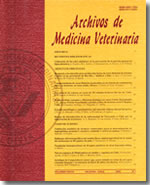Antimicrobial resistance monitoring in cattle in Chile using E. coli as the indicator bacteria
Main Article Content
Abstract
Antimicrobial resistance is an important worldwide public health problem having a negative impact on the struggle against bacterial diseases. The WHO indicates that there exists evidence that livestock are a reservoir for resistant bacteria and that medical physicians and veterinarians must work together on this problem. The aim of the present study was to monitor the antimicrobial resistance in cattle, using E. coli as the indicator bacteria. Fifty E. coli strains were isolated from caecal contents of dairy cattle (Group I) and 72 from beef cattle (Group II). The Minimal Inhibitory Concentrations to eight antimicrobial drugs were determined. The highest resistance percentages (86%) were observed in group I strains; whereas in beef cattle this value was under 11%. In the Group I strains the major levels of resistance were observed against ciprofloxacin, ceftiofur, enrofloxacin and oxitetracycline and in Group II, strains resistant to sulfamethoxazol/trimethoprim were observed. High multiresistance percentages were observed in the Group I with the profile enrofloxacin/ciprofloxacin/oxitetracycline/ceftiofur being the most common (46%). This situation contrasted with that observed in Group II strains, where less than 3% of the strains were multiresistant. It was concluded that antimicrobial resistance is present in both dairy and beef cattle in the Metropolitan Region, as has been reported in other regions of the country.

